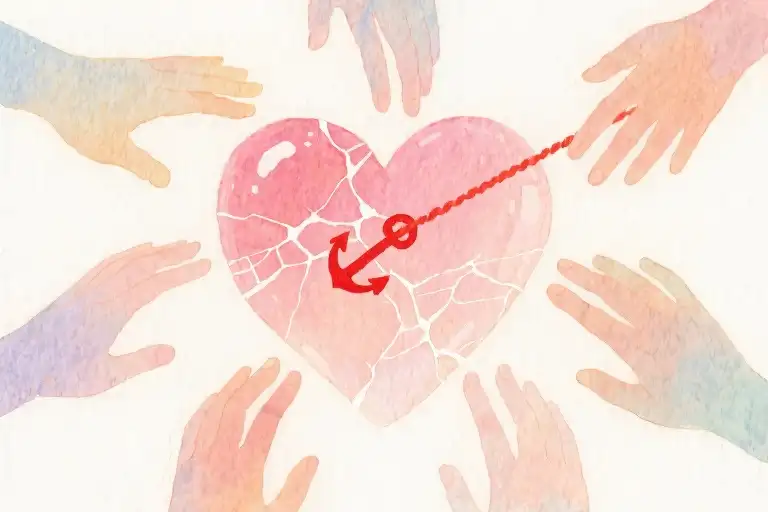There was a girl I used to know, she looked a lot like me.
She moved through the world like an emotional first responder—always on call, always anticipating the next crisis. Her superpower? Sensing heartbreak three tables away at a coffee shop. Hearing the unspoken grief in someone’s throat before their voice even cracked. The kind of person who’d apologize when your foot stepped on hers, who’d linger on phone calls listening to dial tones just in case the other person had one last thought to share.
We praise this as empathy. We call it kindness. We crown it virtue. But here’s the uncomfortable truth no one tells you: Unbounded empathy is self-abandonment wearing a disguise. That girl—that version of me—wore her exhaustion like jewelry, mistaking depletion for depth.
Look at me, the posture said, I’m so full of love I don’t even need a spine.
This isn’t a condemnation of empathy—that radiant human ability to feel with others. This is about the dark side of emotional labor we rarely discuss: how empathy burnout creeps in when we forget that compassion needs containers. How the very trait that makes HSPs (highly sensitive persons) extraordinary—their emotional permeability—becomes a backdoor for self-betrayal.
I remember the exact moment I realized my “open door policy” had turned my inner world into a boarding house for other people’s chaos. My mind—this sacred space meant to shelter my dreams, my fears, my becoming—had morphed into a 24/7 emotional convenience store. Everyone helped themselves to my attention, my energy, my silence. And I? I stood in the corner like a ghost in my own life, watching strangers trample my peace with muddy boots.
It took me years to name that scene for what it was: not generosity, but self-sacrifice syndrome. Not love, but a slow-motion vanishing. The cruelest part? The trespassers weren’t villains—they were just people I’d trained to believe my boundaries were flexible.
That’s the paradox of emotional boundaries: We think we’re being kind by making endless space for others, until one day we wake up homeless in our own lives. What feels like “giving” is often just graceful self-erasure.
Here’s what I wish someone had told me earlier: Empathy without limits isn’t strength—it’s the absence of self-protection. That girl I used to be? She didn’t need more love to give. She needed the courage to say, This far, no further. She needed to learn that true compassion includes compassion for oneself.
Because here’s the secret no one mentions about healthy empathy: It has a threshold. It says I feel with you but not I’ll disappear for you. It recognizes that drowning people can’t save drowning people—that sometimes the kindest act is handing someone a life preserver while staying firmly in your own boat.
That girl I used to know? She’s still here. But now she understands: Even the softest hearts need spines. Even the most open hands must sometimes close. And the most revolutionary act of love isn’t endless giving—it’s knowing when to say enough.
The Hidden Cost of Being an Empathy Superhero
You know that person who always senses the unspoken tension in a room? Who carries tissues for others’ tears but forgets their own needs? That was me – an emotional first responder running toward crises nobody asked me to solve. If empathy were a superpower, I wore my cape with quiet pride, never realizing how heavy it would become.
5 Telltale Signs You’re an HSP (Highly Sensitive Person)
- The Apology Reflex: Saying “sorry” when someone bumps into YOU, as if your mere existence inconveniences the world
- Emotional Echoes: Carrying others’ moods like they’re your own – a coworker’s bad day becomes your emotional hangover
- The Pause Button Life: Always waiting three extra seconds before hanging up, just in case the other person has “one more thing”
- Boundary Amnesia: Treating your personal limits like vague suggestions rather than non-negotiable rules
- Exhaustion Alchemy: Magically transforming social interactions into energy debt (that coffee “catch-up” leaves you needing a three-day recovery)
Why Society Rewards Our Burnout
We live in a world that romanticizes emotional labor, especially from women. The “good listener” gets praise like:
- “You’re so easy to talk to” (translation: you never interrupt with your own needs)
- “You just get people” (translation: you do the emotional heavy lifting in relationships)
Psychology explains our phone-hangup hesitation: it’s hyper-vigilance – our nervous systems stuck in permanent “scan mode” for distress signals. That 3-second pause? That’s your brain saying: “Wait, did I miss any hidden pain I should absorb?”
The Empathy Deception
Here’s what nobody tells sensitive souls: Unbounded empathy is self-abandonment in disguise. Like overwatering a plant until its roots rot, we drown ourselves in others’ needs until our own emotional ecosystem collapses.
That “open house” feeling? It’s not hospitality – it’s a quiet evacuation from your own life. You become a museum curator for others’ emotional artifacts while your own heart gathers dust in storage.
“Empathy without boundaries is like breathing without exhaling – eventually, you suffocate on borrowed air.”
Tomorrow we’ll explore how to rebuild your emotional architecture. But for tonight? Just notice: when you hang up the phone next time, try doing it on YOUR terms. That silent click is the sound of your first boundary being born.
When Kindness Becomes Self-Expulsion
That girl I used to know? She mistook self-abandonment for saintliness. Her open-door policy for other people’s emotions left her own psyche homeless. Let’s walk through the three rooms of this metaphorical house to understand how unchecked empathy becomes self-harm.
The Foyer: Space Invasion
Healthy boundaries act like a welcome mat – they let visitors know where the shoes come off. Without them, every passing complaint, every casual negativity tromps through your mental space with muddy boots. HSPs (highly sensitive persons) often report physical sensations when this happens: a tight chest when absorbing a friend’s anxiety, literal weight on shoulders when carrying others’ burdens.
Funny how we’ll rearrange furniture to accommodate guests who’d never think to ask.
The Living Room: Resource Depletion
Chronic empathy burnout correlates with 23% higher cortisol levels according to HSP research. Your body keeps score even when your people-pleasing mind doesn’t. That “emotional sponge” quality? It’s not a superpower when you’re wringing yourself dry for others. The living room becomes cluttered with:
- Unprocessed emotions you “temporarily” took on
- Half-finished conversations where your needs went unspoken
- The invisible labor of anticipating others’ moods
The Bedroom: Sovereignty Lost
The final frontier isn’t about physical space – it’s the quiet violence of self-erasure. When you habitually:
- Apologize for existing (“Sorry for bothering you…”)
- Mistake endurance for virtue (“I can handle it”)
- Feel guilty for needing basic care
…you’ve handed over the keys to your wellbeing. Social conditioning rewards this “saintly” self-sacrifice, especially for women in caregiving roles. We mistake martyrdom for maturity.
The cognitive distortion: If I’m not needed, do I matter? If I’m not useful, am I loved? This false equation turns kindness into currency.
That girl finally saw the eviction notice she’d been writing herself. Not with malice, but with a thousand tiny surrenders. The body always knows – the headaches, the insomnia, the way your breath catches when yet another “small favor” gets added to your load. These aren’t failures of generosity. They’re boundary violations wearing kindness costumes.
Your turn: Where in your life have you confused “open-hearted” with “open-season”? What rooms in your psyche need a “private – do not disturb” sign?
Rebuilding Your Emotional Boundaries: A Practical Toolkit
The Three-Step Boundary Framework
Healthy emotional boundaries aren’t built overnight – they’re constructed through conscious practice. This three-tier model helps HSPs transition from perpetual givers to balanced empathizers:
- Recognition Radar
- Physical signals: Fatigue after social interactions, tension headaches
- Emotional tells: Resentment disguised as concern, habitual guilt when saying no
- Behavioral markers: Over-explaining decisions, minimizing your needs with “it’s fine”
- Verbal Scaffolding
- Workplace script: “I’d need to check my bandwidth before committing to this”
- Relationship phrase: “I care about you, but I’m not in the right headspace for this conversation”
- Social template: “I appreciate the invitation, but I’m honoring my quiet time tonight”
- Maintenance Rituals
- Daily: 5-minute emotional inventory (ask: “Whose feelings was I carrying today?”)
- Weekly: Digital detox from “emotional vampires” (mute, don’t mute, sometimes mute)
- Monthly: Re-evaluate relationships using the 80/20 rule (are you giving 80% consistently?)
Scenario-Specific Boundary Scripts
For The Workplace Empath:
When colleagues trauma-dump during lunch breaks:
“I really value our connection, but I need to protect my mental energy for afternoon tasks. Maybe we could schedule a proper catch-up later?” (Notice the absence of apology words)
For The Family Peacekeeper:
During toxic family gatherings:
“I’m going to step outside for some air” (physical boundary) followed by
“I don’t feel comfortable discussing that topic” (emotional boundary)
For The Friend-Therapist:
When friends expect free counseling:
“I’m not qualified to help with this, but I can send you some therapist recommendations” (Protects both parties)
The GROUNDING Technique (Visual Guide)
When you’ve overextended and need immediate centering:
- Grasp – Hold a textured object (keys, stone) and describe its physical properties
- Recite – Name 3 neutral facts about your current environment
- Observe – Notice where your body contacts surfaces without judgment
- Unclench – Systematically release jaw, shoulders, fists
- Navigate – Physically reposition yourself (stand if seated, move rooms)
- Distance – Visualize placing overwhelming emotions in a container
- Inquire – Ask “What do I need right now?” (not what others need)
- Nourish – Drink water or eat something grounding (bananas, nuts)
- Graduate – Decide one micro-action to reclaim agency
Simple line drawings showing each step
The Empathy Budget System
Treat your emotional energy like a finite currency:
- Essential Expenses (non-negotiable investments): Close relationships, core values
- Discretionary Spending (conscious choices): Acquaintances, optional commitments
- Debts to Collect (rebalancing imbalanced relationships): People who rarely reciprocate
Track for one week:
- Where did you overspend?
- What relationships give emotional ROI?
- Which interactions need renegotiation?
Boundary Reinforcement Phrases
When guilt creeps in, remember:
- “My no is complete as a sentence”
- “Choosing myself isn’t abandoning others”
- “I’m responsible for my comfort, not others’ convenience”
- “This feels hard because it’s new, not wrong”
- “I teach people how to love me by what I allow”
The Permission Slip Exercise
Write these down verbatim and post visibly:
“I have permission to…
- Exit conversations that drain me
- Take 24 hours to respond to emotional requests
- Protect my energy without justifying
- Let others manage their own discomfort”
Digital Boundary Settings
For HSPs drowning in others’ emotions online:
- App Limits: Set daily 15-minute caps on messaging apps
- Notification Filters: Mute “urgency words” (help, emergency, need) from non-contacts
- Email Templates: “Thanks for sharing – I’m focusing on personal projects right now”
- Social Media: Create a “nurturing only” alt account following just positive content
Remember: Boundaries aren’t rejection – they’re the foundation for sustainable connection. Start small, but start today. That open house? It deserves a “private residence” sign.
From Self-Betrayal to Emotional Sovereignty
That girl I used to know? She’s learning to renovate her open house. Not with higher fences or barred windows, but with something far more revolutionary – a doorbell. The kind you can choose not to answer when your emotional resources are depleted. This isn’t about becoming less empathetic; it’s about discovering what healthy empathy actually looks like.
The Four Pillars of Sustainable Empathy
- Reciprocal Energy Exchange
Healthy empathy functions like a well-designed ventilation system – it allows emotional air to circulate without creating toxic drafts. When you find yourself constantly giving without receiving (that unpaid therapist role with friends, the emotional labor at work), it’s not nobility – it’s an energy leak. Track your conversations this week: How often do others ask “How are you really?” with genuine space for your answer? - Conscious Consent
True connection requires permission. Before automatically absorbing someone’s distress (that coworker venting for 45 minutes, the relative trauma-dumping at family dinners), pause and ask internally: “Do I have capacity for this right now?” Like declining a video call when you’re in pajamas, setting boundaries isn’t rejection – it’s respect for your current state. - Differentiation
Develop what psychologists call “self-other clarity.” Picture wearing noise-canceling headphones that let you hear others clearly while maintaining your own audio baseline. When a friend’s divorce anxiety keeps you up at night, ask: “Is this my heartbreak or theirs?” HSPs often mistake this for coldness – it’s actually the foundation of sustainable care. - Replenishment Rituals
Treat your empathy like a specialized muscle group. After intense emotional engagement (helping a grieving neighbor, mediating family conflict), schedule “compassion recovery time” – twenty minutes of forest bathing, a solo dance party, or simply staring at clouds. These aren’t indulgences; they’re the physiological reset your nervous system requires.
Cognitive Reframing: “No” as a Filter System
That knee-jerk guilt when declining requests? It’s not a warning siren – it’s a faulty alarm system installed by people who benefited from your unlimited access. Try this mental upgrade:
- Old program: “Saying no means I’m selfish”
- New code: “My no creates space for more aligned yeses”
Case Study:
Pre-Boundary Sarah would cancel therapy appointments to listen to her sister’s relationship dramas (again). Post-Boundary Sarah texts: “I care about you and want to be fully present. Let’s schedule a proper catch-up this weekend when I’m off work.” The result? Their conversations now have depth instead of dependency.
Behavioral Upgrade: Side-by-Side Comparison
| Situation | Self-Abandoning Response | Sovereign Response |
|---|---|---|
| Colleague vents daily | Nodding while suppressing panic about your own deadlines | “I can listen for 5 minutes, then I need to focus” |
| Friend texts crisis at 2AM | Responding immediately, losing sleep | “I’m offline right now but will check in at 9AM” |
| Family criticizes boundaries | Apologizing and overexplaining | “This is what I need to stay healthy” (no justification) |
Notice how the sovereign responses share three elements:
- Clear declaration of needs
- Absence of self-deprecation
- Unshaken by others’ discomfort
The Empathy Evolution
That girl who waited on silent phones? She’s learning to say “I’ll let you go now” without guilt. The woman who apologized for others stepping on her? She’s designing life where fewer feet wander unchecked through her psychological space. This isn’t the loss of some sacred gift – it’s the long-delayed honoring of your most sacred responsibility: keeping yourself safe, whole, and emotionally resourced.
Your turn: Take one situation from your week where old patterns emerged. Rewrite it using the sovereign response framework. Notice where resistance arises – those are your growth points shining through.
Reclaiming Your Space: The Final Lockdown
That girl I once knew? She’s learning to change the locks. Not with anger, but with the quiet determination of someone who finally understands: a home with no doors isn’t hospitable—it’s haunted.
The Metaphor Comes Full Circle
Remember the “open house” we discussed? Where your peace was trampled by uninvited chaos? Picture now a different scene:
- New deadbolt: Your “no” becomes a physical barrier
- Stained glass windows: Transparency without fragility
- Porch light timer: Controlled availability (you decide visiting hours)
This isn’t isolation—it’s intentional hosting. Like any responsible homeowner, you now:
- Check credentials (“Does this align with my values?”)
- Collect keys selectively (“Who gets emergency access?”)
- Schedule renovations (“Monthly emotional maintenance”)
Your Boundary Manifesto
Let’s make it tangible. Complete this writing exercise (find a pen—this works better handwritten):
“I, [Your Name], being of sound mind and tired spirit, hereby declare:
- My emotional bandwidth is not public Wi-Fi
- My silence ≠ consent to emotional dumpster diving
- I reserve the right to:
- Charge emotional “rent” (reciprocal energy)
- Evict repeat offenders
- Install security systems (therapy, journaling)”
Sign it. Date it. Tape it to your mirror. This isn’t rebellion—it’s the owner’s manual you should’ve received at birth.
The Last Word (For Now)
We end where we began, with that crown. But now you know:
“A crown needs a spine to sit upon.”
Your empathy was never the problem—the throne was missing. Consider this your coronation notice: the reign of self-betrayal ends today.
Your next chapter? It reads like a freshly changed welcome mat:
“Come back when you can treat my heart like the sacred ground it is.”





